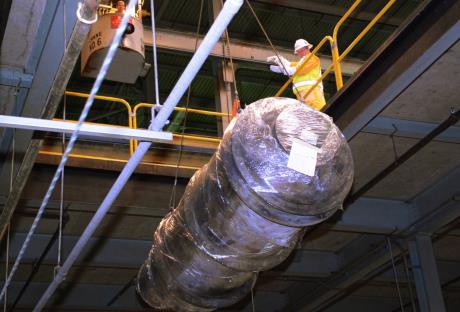The final piece of process gas equipment has been removed from one of three process buildings at the former Portsmouth gaseous diffusion uranium enrichment plant in Ohio, USA.
 |
| The final converter is removed from the cell floor of Building X-326 (Image: Michelle Teeters/Fluor-BWXT Portsmouth) |
Fluor-BWXT-Portsmouth, the US Department of Energy's (DOE) contractor for the decommissioning of the Portsmouth site, removed the last of over 7000 components from the X-326 facility on 21 March. More than 6800 of those components have been shipped offsite for disposal.
The components were part of 2340 enrichment "stages", each consisting of a compressor, a converter and a cooler, plus interconnecting pipes. The converters alone weigh almost 5 tonnes each. Each of Portsmouth's three process buildings - X326, X-330 and X-333 - covers over 12 hectares and housed uranium enrichment equipment. Deactivation activities are under way at all three.
DOE site lead Joel Bradburne said the "difficult and hazardous" work had presented many challenges which had all been met. "The Fluor-BWXT X-326 Deactivation team has removed the largest sources of contamination and safely shipped these components offsite for disposal. In the process the Portsmouth D&D Project has become one of the largest shippers in the DOE complex for offsite disposal," he said.
The deactivation work has presented challenges from radiological, industrial and safety perspectives. These involved chemical hazards and radiological contamination issues. They also included hoisting and rigging, welding and torch cutting, and work in confined spaces. Up to 300 employees and support staff worked on the project.
Work is now under way to characterize auxiliary systems and remove any held-up uranium and hazardous materials inside them. "Our plan is to have the X-326 'cold and dark' and ready for demolition by June of 2017," Bradburne said.
The Portsmouth plant began operations in 1954, originally as part of the USA's nuclear weapons complex, but produced fuel for commercial nuclear plants from the 1960s. Enrichment operations ended in 2001, after which the plant was maintained in cold standby for ten years. Limited cleanup operations began at the site in the 1990s.
The DOE recently approved a 30-month contract option for Fluor-BWXT to finalize X-326 deactivation, fully mobilize deactivation efforts in the X-333 building, and finish design and begin construction of an on-site waste disposal facility to safely dispose of building debris and contaminated soils from plant demolition.
Researched and written
by World Nuclear News




_18570.jpg)
_16159.jpg)
_18938.jpg)
_33584.jpg)





